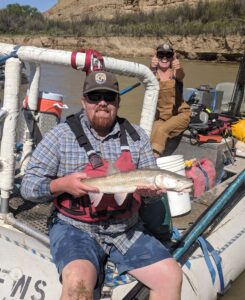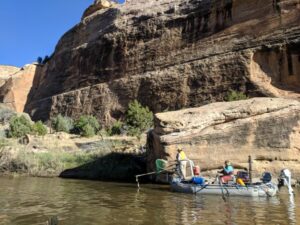Endangered Fish of the Colorado River System
The Green and Yampa Rivers are home to many species of fish, but there are a few that are particularly endangered or at risk of becoming endangered. These species are facing a variety of threats, including habitat loss, pollution, and overfishing. Here is a closer look at some of the most endangered fish on the Green and Yampa Rivers:
- Colorado pikeminnow: This species of fish is native to the Colorado River system, which includes the Green and Yampa Rivers. It is listed as endangered under the Endangered Species Act and is considered one of the most endangered fish in North America. The Colorado pikeminnow is threatened by habitat loss and degradation, as well as non-native species that compete for resources.
- Razorback sucker: The Razorback sucker is another species of fish native to the Colorado River system that is listed as endangered. It is a large, bottom-dwelling fish that is known for its distinctive, humped back. The razorback sucker is threatened by habitat loss and degradation, as well as the introduction of non-native species that compete for resources.
- humpback chub: The humpback chub is another endangered species of fish native to the Colorado River system. It is a small, sleek fish with a distinctive hump on its back. The humpback chub is threatened by habitat loss and degradation, as well as the introduction of non-native species that compete for resources.
- bonytail chub: The bonytail chub is another endangered species of fish native to the Colorado River system. It is a large, silvery fish with a distinctive bonytail. The bonytail chub is threatened by habitat loss and degradation, as well as the introduction of non-native species that compete for resources.
There are many efforts underway to protect and preserve these endangered species of fish on the Green and Yampa Rivers. These efforts include habitat restoration projects, the introduction of non-native species that are less damaging to native fish populations, and the implementation of regulations to limit overfishing. It is important that we take action to protect these species, as they are an integral part of the ecosystem and play a vital role in the health and well-being of the Green and Yampa Rivers.
There are several reasons why this information is important to river users. First, it is important to be aware of the species that are present in the rivers and their conservation status because it can impact the types of activities that are allowed or restricted in certain areas. For example, if a certain species of fish is endangered, there may be regulations in place to protect that species, such as catch limits or restrictions on boating or fishing in certain areas.
Second, it is important for river users to be aware of the endangered species present in the rivers because these species play important roles in the ecosystem. For example, the Colorado pikeminnow is a top predator in the Colorado River system and plays a vital role in maintaining the balance of the ecosystem. The loss of this species could have cascading effects on the entire ecosystem.
Third, protecting endangered species can help to preserve the biodiversity of the Green and Yampa Rivers. Biodiversity is important because it helps to ensure the health and resilience of the ecosystem. A diverse range of species can help to protect against the impacts of environmental changes, such as drought or pollution.
Finally, protecting endangered species can have economic benefits as well. Many people rely on the rivers for recreation, such as fishing, boating, and rafting, and the presence of endangered species can attract tourists and support local economies.


